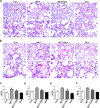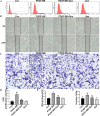Quercetin regulates pulmonary vascular remodeling in pulmonary hypertension by downregulating TGF-β1-Smad2/3 pathway
- PMID: 39367342
- PMCID: PMC11451247
- DOI: 10.1186/s12872-024-04192-4
Quercetin regulates pulmonary vascular remodeling in pulmonary hypertension by downregulating TGF-β1-Smad2/3 pathway
Abstract
Background: Pulmonary arterial hypertension (PAH) is a worldwide challenging disease characterized by progressive elevation of pulmonary artery pressure. The proliferation, migration and phenotypic transformation of pulmonary smooth muscle cells are the key steps of pulmonary vascular remodeling. Quercetin (3,3', 4', 5, 6-pentahydroxyflavone, Que) is a natural flavonol compound that has antioxidant, anti-inflammatory, anti-tumor and other biological activities. Studies have shown that Que has therapeutic effects on PAH. However, the effect of quercetin on pulmonary vascular remodeling in PAH and its mechanism remain unclear.
Methods and results: In vivo, PAH rats were constructed by intraperitoneal injection of monocrotaline (MCT) at 60 mg/kg. Human pulmonary artery smooth muscle cells (HPASMCs) were treated with platelet-derived growth factor BB (PDGF-BB) 20 ng/mL to construct PAH cell model in vitro. The results showed that in vivo studies, MCT could induce right ventricular wall hyperplasia, narrow the small and medium pulmonary artery cavity, up-regulate the expression of proliferating and migration-related proteins proliferating cell nuclear antigen (PCNA) and osteopontin (OPN), and down-regulate the expression of alpha-smooth muscle actin (α-SMA). Que reversed the MCT-induced results. This process works by down-regulating the transforming growth factor-β1 (TGF-β1)/ Smad2/3 signaling pathway. In vitro studies, Que had the same effect on PDGF-BB-induced proliferation and migration cell models.
Conclusions: Que inhibits the proliferation, migration and phenotypic transformation of HPASMCs by down-regulating TGF-β1/Smad2/Smad3 pathway, thereby reducing right ventricular hyperplasia (RVH) and pulmonary vascular remodeling, providing potential pharmacological and molecular explanations for the treatment of PAH.
Keywords: Migration; PAH; Proliferation; Que; TGF-β1.
© 2024. The Author(s).
Conflict of interest statement
The authors declare no competing interests.
Figures







Similar articles
-
MicroRNA-663 prevents monocrotaline-induced pulmonary arterial hypertension by targeting TGF-β1/smad2/3 signaling.J Mol Cell Cardiol. 2021 Dec;161:9-22. doi: 10.1016/j.yjmcc.2021.07.010. Epub 2021 Jul 31. J Mol Cell Cardiol. 2021. PMID: 34339758
-
Corosolic acid attenuates platelet-derived growth factor signaling in macrophages and smooth muscle cells of pulmonary arterial hypertension.Eur J Pharmacol. 2024 Jun 15;973:176564. doi: 10.1016/j.ejphar.2024.176564. Epub 2024 Apr 16. Eur J Pharmacol. 2024. PMID: 38614383
-
Bioactive Compounds From Coptidis Rhizoma Alleviate Pulmonary Arterial Hypertension by Inhibiting Pulmonary Artery Smooth Muscle Cells' Proliferation and Migration.J Cardiovasc Pharmacol. 2021 Aug 1;78(2):253-262. doi: 10.1097/FJC.0000000000001068. J Cardiovasc Pharmacol. 2021. PMID: 34554677
-
NOTCH3 and Pulmonary Arterial Hypertension.Int J Mol Sci. 2024 Jun 6;25(11):6248. doi: 10.3390/ijms25116248. Int J Mol Sci. 2024. PMID: 38892440 Free PMC article. Review.
-
The Search for Disease-Modifying Therapies in Pulmonary Hypertension.J Cardiovasc Pharmacol Ther. 2019 Jul;24(4):334-354. doi: 10.1177/1074248419829172. Epub 2019 Feb 17. J Cardiovasc Pharmacol Ther. 2019. PMID: 30773044 Free PMC article. Review.
Cited by
-
Emerging Mechanistic Insights and Therapeutic Strategies for Pulmonary Arterial Hypertension: A Focus on Right Ventricular Dysfunction and Novel Treatment Pathways.Biomedicines. 2025 Mar 1;13(3):600. doi: 10.3390/biomedicines13030600. Biomedicines. 2025. PMID: 40149576 Free PMC article. Review.
-
Quercetin in Idiopathic Pulmonary Fibrosis and Its Comorbidities: Gene Regulatory Mechanisms and Therapeutic Implications.Genes (Basel). 2025 Jul 23;16(8):856. doi: 10.3390/genes16080856. Genes (Basel). 2025. PMID: 40869904 Free PMC article. Review.
-
TCF7 enhances pulmonary hypertension by boosting stressed natural killer cells and their interaction with pulmonary arterial smooth muscle cells.Respir Res. 2025 May 29;26(1):202. doi: 10.1186/s12931-025-03276-9. Respir Res. 2025. PMID: 40442690 Free PMC article.
-
Bioactive compound combinations from Rhodiola tangutica alleviate pulmonary vascular remodeling in high-altitude pulmonary hypertension rats through the PI3K-AKT pathway.Front Pharmacol. 2025 May 2;16:1582677. doi: 10.3389/fphar.2025.1582677. eCollection 2025. Front Pharmacol. 2025. PMID: 40385484 Free PMC article.
References
-
- Lei S, Peng F, Li ML, et al. LncRNA-SMILR modulates RhoA/ROCKsignaling by targeting miR-141 to regulate vascular remodeling in pulmonaryarterial hypertension. Am J Physiol Heart Circ Physiol. 2020;319:H377–91. - PubMed
-
- Courboulin A, Barrier M, Perreault T, et al. Plumbaginreverses proliferation and resistance to apoptosis in experimental PAH. EurRespir J. 2012;40:618–29. - PubMed
-
- Wang SC. PCNA: a silent housekeeper or a potential therapeutic target. Trends Pharmacol Sci. 2014;35:178–86. - PubMed
MeSH terms
Substances
LinkOut - more resources
Full Text Sources
Research Materials
Miscellaneous

